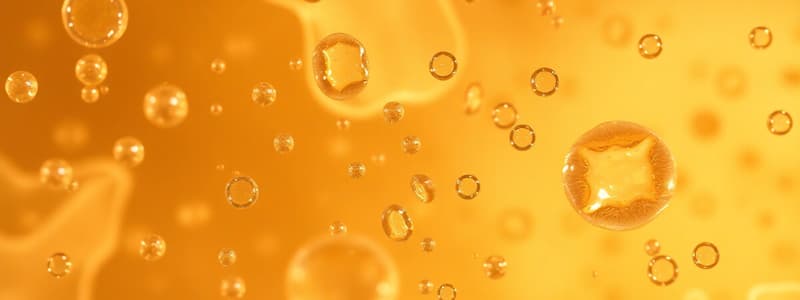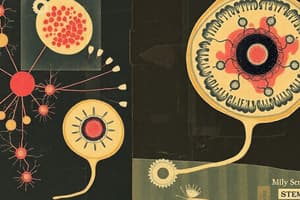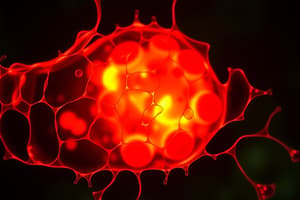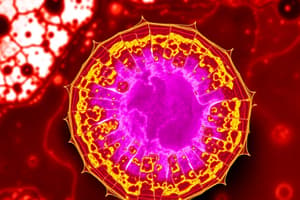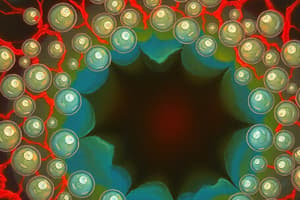Podcast
Questions and Answers
What is the smallest living thing?
What is the smallest living thing?
Cells
What subunits, structural and functional, are cells?
What subunits, structural and functional, are cells?
Cells are the structural and functional subunits of all of our body systems.
What is the study of cells called?
What is the study of cells called?
Cell Biology
Name the three principal parts of a cell.
Name the three principal parts of a cell.
What is the flexible outer surface of the cell?
What is the flexible outer surface of the cell?
What part of the cell contains numerous organelles surrounded by cytosol?
What part of the cell contains numerous organelles surrounded by cytosol?
What large organelle contains the cells chromosomes?
What large organelle contains the cells chromosomes?
The plasma membrane is a weak, inflexible barrier between the interior of a cell and the outside world.
The plasma membrane is a weak, inflexible barrier between the interior of a cell and the outside world.
What does the fluid mosaic model describe?
What does the fluid mosaic model describe?
A bilayer of carbohydrates provides a structural foundation within the cell.
A bilayer of carbohydrates provides a structural foundation within the cell.
All proteins are unable to move freely within the cell.
All proteins are unable to move freely within the cell.
The plasma membrane is the major means that cells use to communicate with other cells and with the environment.
The plasma membrane is the major means that cells use to communicate with other cells and with the environment.
Phospholipid bilayers are effective barriers for nonpolar and uncharged molecules, and for ions
Phospholipid bilayers are effective barriers for nonpolar and uncharged molecules, and for ions
Which of these lipids are found in animal cell membranes?
Which of these lipids are found in animal cell membranes?
Which of the following is NOT a sub-class of membrane proteins?
Which of the following is NOT a sub-class of membrane proteins?
What type of membrane protein allows specific ions to move through a water-filled pore?
What type of membrane protein allows specific ions to move through a water-filled pore?
What type of integral membrane protein carries substances across the plasma membrane by changing shape?
What type of integral membrane protein carries substances across the plasma membrane by changing shape?
What membrane protein recognizes specific ligands and alters the cell's function in some way?
What membrane protein recognizes specific ligands and alters the cell's function in some way?
What type of membrane protein catalyzes reactions inside or outside the cell?
What type of membrane protein catalyzes reactions inside or outside the cell?
What type of membrane protein anchors filaments inside and outside the plasma membrane?
What type of membrane protein anchors filaments inside and outside the plasma membrane?
What type of membrane protein distinguishes your cells from anyone else's?
What type of membrane protein distinguishes your cells from anyone else's?
What is membrane fluidity?
What is membrane fluidity?
What process pumps ions 'uphill' (against their concentration gradients)?
What process pumps ions 'uphill' (against their concentration gradients)?
What are the 2 types of secondary active transport?
What are the 2 types of secondary active transport?
Vesicles are large irregular membrane sacs.
Vesicles are large irregular membrane sacs.
What is the process where cells allows some cells to 'eat' large particles?
What is the process where cells allows some cells to 'eat' large particles?
What process takes in fluid and smalls solutes together?
What process takes in fluid and smalls solutes together?
What process allows cells to transport large chemicals across an epithelium?
What process allows cells to transport large chemicals across an epithelium?
What does cytoplasm consists of?
What does cytoplasm consists of?
What network of protein filaments stretches throughout the cytosol?
What network of protein filaments stretches throughout the cytosol?
The centrosome makes new microtubules in dividing cells.
The centrosome makes new microtubules in dividing cells.
Flagella move fluid along the cell surface.
Flagella move fluid along the cell surface.
Which of the following describes the function of ribosomes?
Which of the following describes the function of ribosomes?
What are ribosomes made of?
What are ribosomes made of?
What does the nucleus do?
What does the nucleus do?
What is the nucleolus?
What is the nucleolus?
What is contained within chromosomes?
What is contained within chromosomes?
What is transcription?
What is transcription?
Transcription transfers genetic information from which of these major classes of RNA?
Transcription transfers genetic information from which of these major classes of RNA?
What is the enzyme that creates the RNA molecules?
What is the enzyme that creates the RNA molecules?
What is the function of tRNA?
What is the function of tRNA?
What are the stages of the cell cycle?
What are the stages of the cell cycle?
Name the phases of mitosis.
Name the phases of mitosis.
What are gametes?
What are gametes?
What is crossing over?
What is crossing over?
Flashcards
Cell Biology
Cell Biology
The study of cells, including their structure and chemical reactions.
Plasma Membrane
Plasma Membrane
Flexible outer surface of a cell, acting as a barrier.
Cytoplasm
Cytoplasm
The cells internal substance containing organelles and cytosol.
Nucleus
Nucleus
Signup and view all the flashcards
Fluid Mosaic Model
Fluid Mosaic Model
Signup and view all the flashcards
Phospholipid Bilayers
Phospholipid Bilayers
Signup and view all the flashcards
Integral Proteins
Integral Proteins
Signup and view all the flashcards
Peripheral Proteins
Peripheral Proteins
Signup and view all the flashcards
Glycoproteins
Glycoproteins
Signup and view all the flashcards
Membrane Fluidity
Membrane Fluidity
Signup and view all the flashcards
Membrane Permeability
Membrane Permeability
Signup and view all the flashcards
Passive Processes
Passive Processes
Signup and view all the flashcards
Simple Diffusion
Simple Diffusion
Signup and view all the flashcards
Active Processes
Active Processes
Signup and view all the flashcards
Facilitated Diffusion
Facilitated Diffusion
Signup and view all the flashcards
Osmosis
Osmosis
Signup and view all the flashcards
Isotonic Solutions
Isotonic Solutions
Signup and view all the flashcards
Hypotonic Solution
Hypotonic Solution
Signup and view all the flashcards
Hypertonic Solutions
Hypertonic Solutions
Signup and view all the flashcards
Primary Active Transport
Primary Active Transport
Signup and view all the flashcards
Secondary Active Transport
Secondary Active Transport
Signup and view all the flashcards
Vesicles
Vesicles
Signup and view all the flashcards
Phagocytosis
Phagocytosis
Signup and view all the flashcards
Cytosol
Cytosol
Signup and view all the flashcards
Cytoskeleton
Cytoskeleton
Signup and view all the flashcards
Centrosome
Centrosome
Signup and view all the flashcards
Cilia
Cilia
Signup and view all the flashcards
Ribosomes
Ribosomes
Signup and view all the flashcards
RNA
RNA
Signup and view all the flashcards
Mitosis
Mitosis
Signup and view all the flashcards
Study Notes
- The cellular level of organization concerns cells, the smallest living things.
- Cell biology is the study of cells, including their internal structures and chemical reactions.
- Cells are the structural and functional subunits of all body systems.
Cells and Parts
- Every cell has three principal parts: plasma membrane, cytoplasm, and nucleus.
- The plasma membrane is the flexible outer surface of the cell.
- The cytoplasm contains numerous organelles surrounded by cytosol.
- The nucleus is a large organelle that contains chromosomes.
Plasma Membrane
- The plasma membrane is a strong but flexible barrier between the interior of a cell and the outside world.
- The fluid mosaic model describes membrane structure.
- A bilayer of phospholipids forms a structural foundation.
- A variety of membrane proteins interact with the lipids.
- Lipids and many proteins are able to move about freely.
- The plasma membrane is the major means that cells use to communicate with each other and the environment.
- Phospholipid bilayers create effective barriers for polar and charged molecules, and ions.
- Cholesterol and glycolipids are two types of lipids found in animal cell membranes.
Membrane Proteins
- Sub-classes of membrane proteins include integral, peripheral, and glycoproteins.
- Ion channels allow specific ions to move through water-filled pores.
- Carrier proteins transport specific substances across the membrane by changing shape.
- Amino acids, needed to synthesize new proteins, enter body cells via carriers.
- Carrier proteins are also known as transporters.
- Receptor proteins recognize specific ligands and alter cell function.
- Antidiuretic hormone binds to receptors in the kidneys and changes the water permeability of certain plasma membranes.
- Enzymes catalyze reactions inside or outside the cell, depending on which direction the active site faces.
- Linker proteins anchor filaments inside and outside the plasma membrane, which provides structural stability and shape for the cell.
- Cell-identity markers such as glycoproteins distinguish cells from each other.
Membrane Fluidity and Permeability
- Various membrane functions require a balance between strength and flexibility of the membrane.
- Membrane fluidity refers to the viscosity of the lipid bilayer.
- Membrane fluidity depends mainly on the number of double bonds in the membranes' fatty acids.
- Small and non-polar molecules pass easily through phospholipid bilayers.
- The permeability of membranes to ions/polar molecules depends on the number of specific transport proteins.
- How quickly ions and molecules cross membranes relies on concentration and electrical gradients.
Active and Passive Processes
- Transport of molecules or ions across membranes can be classified as either passive or active.
- Passive processes are spontaneous with chemicals moving based on their kinetic energy.
- Movement goes from higher to lower concentrations ("downhill").
- Examples include simple diffusion, facilitated diffusion, and osmosis.
- Active processes require stored energy for chemicals to move.
- Movement is from lower to higher concentrations ("uphill").
- Examples include primary and secondary active transport, and endocytosis.
Diffusion
- The movement of solutes directly through the lipid bilayer is called simple diffusion.
- The movement of solutes with the help of membrane proteins is called facilitated diffusion.
- The rate of diffusion depends on the concentration gradient, temperature, mass of diffusing molecules, membrane surface area, and diffusion distance.
- Non-polar molecules move via simple diffusion.
- Many ions cross membranes through ion channels.
- Polar molecules are transported by carrier-mediated facilitated diffusion.
Osmosis
- Most membranes are selectively permeable, and allow water to move much more quickly than many solutes.
- Water moves in response to differences in solute concentrations, going toward the higher solute level.
- Osmotic gradients can have dramatic effects on cells.
- The three types of solutions are hypotonic, isotonic, and hypertonic.
- Most of our body fluids and cells are in osmotic equilibrium because water moves quickly.
Active Transport
- Energy is a requirement to move molecules, referred to as moving "uphill".
- Primary active transport uses ATP as the source of energy.
- Secondary active transport employs ion gradients as the source of energy.
- Vesicles can transport some large molecules into (endocytosis) and out of (exocytosis) cells without breaking them down.
- Primary active transport pumps ions "uphill" against their concentration gradients.
- ATP hydrolysis is used to power the process of primary active transport.
- The Na+/K+ pump and Ca2+/Mg2+ pump are examples of primary active transport.
- Secondary active transport also moves ions or molecules “uphill”, against their concentration gradients.
- Symporters and antiporters are two types of secondary active transport where many specific examples of each type exist in cells.
- Vesicles are small, spherical membrane sacs used to move large molecules in and out of cells, and between organelles.
- Receptor-mediated endocytosis is an important example.
- Phagocytosis allows some cells to "eat" large particles.
- Bulk-phase endocytosis allows cells to take in fluid and small solutes together.
- Transcytosis allows cells to transport large chemicals across an epithelium.
Cytoplasm
- This is everything between the nucleus and the cell membrane.
- Cytosol is the intracellular fluid, mostly water with many dissolved chemicals.
- Organelles are structures that each perform specific functions for the cell.
- The cytoskeleton is a network of protein filaments that stretches throughout the cytosol.
- Major functions include determining cell shape, organizing the contents of the cell, moving organelles, moving chromosomes during cell division, and creating/moving membrane vesicles (in phagocytosis, etc).
Centrosome
- The centrosome makes new microtubules in nondividing cells.
- The centrosome forms the mitotic spindle during cell division.
Cilia and Flagella
- Cilia move fluid along the cell surface.
- Flagella move cells through the medium.
Ribosomes
- Ribosomes have two major subunits made of both RNA and proteins.free
- Free ribosomes make proteins used in the cytosol.
- Attached ribosomes make proteins used in membranes and for export.
Endoplasmic Reticulum (ER)
- The endoplasmic reticulum (or just “ER”) is an extensive membrane network within the cytosol.
- Rough ER contains bound ribosomes.
- Smooth ER has enzymes involved in metabolism of lipids and drugs.
Golgi Complex
- Modifies and sorts proteins produced by the rough ER
- Generates vesicles for moving molecules around inside
Lysosomes, Peroxisomes, Proteasomes
- Lysosomes contain digestive enzymes used to break down ingested material, worn-out parts of cells, and the entire cell.
- Peroxisomes contain oxidative enzymes important in metabolism.
- Proteasomes break down worn out or unneeded proteins.
Mitochondria
- Mitochondria contain enzymes that help cells produce large amounts of ATP in a process called cellular respiration.
- Mitochondria contain both an inner and outer membrane.
- Mitochondria self-replicate, using their own ribosomes, also containing some of their genes on their own DNA.
Nucleus
- The nucleus acts as the central control center of the cell.
- A double-walled nuclear envelope separates the nucleus from the cytoplasm.
- The nucleolus is a site within the nucleus that produces new ribosomes.
- Chromosomes contain genes which store the information to build and run cells.
- The human genome consists of 23 pairs of chromosomes.
- Each chromosome contains DNA combined with histone proteins to form chromatin.
- Histones allow DNA to be tightly packed.
- Sister chromatids are connected at the centromere after DNA replication.
Genetic Information
- Transcription is the process where a DNA sequence is copied (or transcribed) into an RNA sequence.
- Messenger RNA (mRNA) contains a sequence to encode proteins.
- The mRNA sequence is used to make new proteins in a process called translation.
- Transcription transfers genetic information from DNA into one of three major classes of RNA (messenger, ribosomal, and transfer RNA).
- RNA polymerase, an enzyme, creates RNA molecules.
- Regulation of transcription is a way that cells control which proteins get made.
Translation
- Ribosomes have two subunits and combine when mRNA is available.
- Ribosomes are made of proteins and rRNA, and have multiple binding sites for mRNA and tRNA.
- tRNA's help line up the correct amino acids to make a new protein.
- All non-gamete producing cells of the body are produced by mitosis.
Cell Division
- The cell cycle is an orderly sequence of events by which somatic cells replicate.
- Cells grow and duplicate their DNA during interphase.
- Cells divide their chromosomes and nuclei during mitosis.
- After mitosis, cells finish dividing during cytokinesis.
- DNA molecules are copied during the S phase.
- Chromosomes are divided into stages including interphase, prophase, metaphase, anaphase, telophase.
- The structure of the double helix allows both copies of the new DNA to have the same sequence.
- At the end of the S phase, sister chromatids have been created even though they are not visible until mitosis.
- Meiosis = Reproductive Cell Division.
- Gametes are unique cells formed in sexual reproduction.
- Gametes contain half as many chromosomes as all other cells and are referred to as haploid cells.
- Chromosome pairs exchange DNA early in the first division in a process called crossing over, a form of genetic recombination.
- At fertilization, male and female gametes combine to create a new diploid individual, which will then undergo mitosis.
Studying That Suits You
Use AI to generate personalized quizzes and flashcards to suit your learning preferences.
